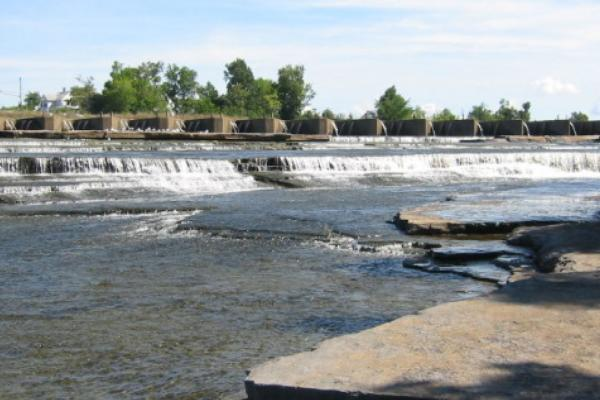
Digital Infrastructure
Introduction
Watertown, NY stands at the cusp of a high-tech opportunity: harnessing the Black River to power and cool new AI server farms (data centers). By leveraging the river’s abundant hydroelectric energy and cold water, Watertown can attract medium-to-large AI data centers while driving economic growth for the community. This report details the available river resources, the requirements of AI data centers, potential sites and regulatory considerations, economic impact projections, and the broader benefits and strategic advantages for Watertown. It concludes with policy recommendations to mobilize this initiative into reality.
Modern data centers require robust power and cooling, which Watertown’s Black River can supply. By tapping renewable hydroelectric power and using river water for cooling, AI server farms can operate sustainably and cost-effectively.
Black River Hydroelectric and Cooling Capacity
Hydropower Potential: The Black River flows through Watertown with significant energy potential. Multiple hydroelectric facilities already exist on the river, demonstrating the capacity for renewable power generation. For example, the Glen Park dam just outside Watertown is a 43.7 MW run-of-river hydro plant, producing about 151,611 MWh of clean electricity per year (enough to power ~14,500 homes)eaglecreekre.com. Within the city, the municipal hydro station at Watertown (at Delano Island) has a capacity of 6.6 MWhydroreform.org. Upstream small hydro developments (e.g. at Deferiet and Herrings) add roughly another 20–30 MWhydroreform.orghydroreform.org. In total, over 50 MW of hydro capacity is harnessed along the Black River near Watertown, and these facilities generate hundreds of thousands of MWh annually of carbon-free electricity. This suggests that a substantial block of renewable power is available locally – enough to supply one or several medium-large data centers, which typically require tens of megawatts of power.
Glen Park Dam on the Black River near Watertown. The river’s flow is harnessed by multiple hydroelectric facilities delivering tens of megawatts of renewable power to the grid. These resources could directly power energy-intensive AI computing centers.
Cold Water for Cooling: In addition to electricity, the Black River provides a vast quantity of cold water that can be used as a natural cooling resource. The river’s discharge through Watertown averages on the order of several thousand cubic feet per secondwaterdata.usgs.gov – equivalent to billions of gallons flowing by each day. Even during low flow periods, the volume is enormous relative to cooling needs, ensuring a reliable heat sink. The water temperature, drawn from the Adirondack-fed watershed, stays relatively cool year-round (far cooler than ambient air in summer). This enables techniques like water-side economization or direct river water cooling, where heat exchangers transfer server heat to the river water without consuming it. Notably, the world’s first “zero-water” consumption data center was recently built using a similar approach: it draws from a nearby water body (ocean/river) as a heat sink and consumes no water, produces no wastewater, and requires no cooling towers, since the water is returned after absorbing heatbv.com. Watertown’s Black River affords a comparable opportunity to dissipate data center heat efficiently. By piping river water through a cooling system (and returning it only a few degrees warmer), an AI server farm could be cooled without stressing municipal water supplies or large-scale evaporative cooling. This synergy of renewable power + natural cooling makes the Black River a strategic asset for sustainable data center operations.
Power and Water Requirements of AI Data Centers
Modern AI-focused data centers are power-hungry and heat-intensive, so understanding their requirements is key:
- Power Needs: Medium-to-large AI data centers typically demand on the order of 10–50+ megawatts (MW) of electricity capacity. (For context, 1 MW can power ~800 homes, so 50 MW is equivalent to a city of 40,000 homes.) This power feeds thousands of GPU/CPU servers performing AI computations around the clock. Hyperscale cloud operators often build campuses exceeding 30–100 MW. For example, a cutting-edge floating AI data center recently commissioned in California delivers about 7 MW of IT load in a single facilitybv.com, while global cloud providers are planning massive expansions to meet AI demand – data center power use for AI is expected to reach 90 TWh by 2026 (a tenfold increase from 2022)www2.deloitte.com. Watertown’s local hydro capacity (~50 MW) could thus cover a significant portion of a large data center’s draw or multiple mid-sized facilities, especially if combined with grid supply.
- Cooling and Water Needs: High-density AI servers generate intense heat, and cooling is a major operational factor. Traditional data centers often rely on air cooling augmented by chiller plants and cooling towers – an approach that consumes vast water through evaporation. An average data center uses roughly 300,000 gallons of water per day for cooling, equivalent to the water use of 100,000 homesnews.lenovo.com. In fact, major tech companies’ data centers collectively consumed billions of gallons of fresh water in 2022 for coolinge360.yale.edu. A single large “hyperscale” data center with conventional cooling can require over 50 million gallons of water per year (for evaporative cooling in towers)www2.deloitte.com. This thirst raises sustainability concerns, especially in drought-prone areas. Fortunately, alternatives exist. Liquid cooling (using water or coolant directly at server racks) is far more efficient, reducing cooling electricity use by up to 90% compared to air coolingwww2.deloitte.com. And as noted, using a natural water source as a heat sink can eliminate on-site water consumption entirelybv.com. By situating an AI data center by the Black River, operators can pump river water through heat exchangers for cooling and then return it, drastically cutting or even eliminating the need for consumptive use of clean water. This approach not only conserves water but also slashes cooling energy overhead (water has much higher thermal conductivity than air, meaning less energy is needed to remove heat). In sum, a Black River-cooled facility could meet the high cooling demand of AI hardware in an eco-friendly way. The combination of renewable hydro power and direct water cooling would make the data center exceptionally sustainable – reducing carbon emissions and water usage while also lowering operating costs (power and cooling are two of the largest expenses for data centers).
Available Sites and Permitting in Watertown
Suitable Land Parcels: Watertown and its environs have several potential sites for developing a server farm. Notably, the Jefferson County Industrial Park (located in the Town of Watertown off outer Coffeen Street) offers large, shovel-ready parcels with industrial zoning. This business park has convenient access to Interstate-81 and existing utility infrastructure (electric transmission lines, water lines, and fiber optic connectivity). Local officials are already improving road access – for instance, a dedicated turning lane is being added on Coffeen St to facilitate truck and equipment traffic into the industrial parkwwnytv.com. The park and similar industrial-zoned areas could accommodate a purpose-built data center campus spanning dozens of acres (to host the server buildings, substation, and cooling plant). Another advantage is proximity to the Black River: parcels along the river or near existing hydro stations (such as near Sewalls Island or Water Street in the city) could be explored for direct water access, though floodplain considerations and infrastructure would need evaluation. Additionally, some underutilized brownfield or manufacturing sites in Watertown (e.g. former paper mill properties) might be repurposed for a data center, if they meet the technical criteria (stable ground, access to power and fiber, etc.). An ideal site would balance distance from the river (for easy cooling water intake/discharge) with elevation/security (away from any flood risk), and be well-served by roads and the electric grid. Fortunately, Watertown’s development agencies maintain an inventory of available properties and can guide site selectors to appropriate locations.
Zoning and Permitting: Data centers are generally classified as industrial or utility land uses, which local zoning ordinances in Watertown permit in industrial and some commercial districts. The City of Watertown’s updated zoning code (2023) and the Town of Watertown’s zoning law both allow high-tech facilities in areas designated for industry or business, so a server farm would likely be an allowed use or obtainable via special permit in those zones. Key local approvals would include a site plan review by the planning board (to ensure the site layout, traffic, lighting, noise, etc. meet standards) and building permits for construction. Community stakeholders will be concerned with aesthetics and sound (data centers are relatively quiet, though backup generators and cooling equipment will require noise mitigation), as well as ensuring the facility fits the community’s character. From a state regulatory standpoint, using river water for cooling will trigger environmental permitting. The project would need a State Pollutant Discharge Elimination System (SPDES) permit from the NY Department of Environmental Conservation for returning warmed water to the river (similar to permits held by power plants or Cornell’s lake-source cooling facility). Engineers would design the cooling system to meet thermal discharge limits so as not to harm aquatic life – for example, by diffusing warm water downstream at a controlled rate. A water withdrawal permit might also be required for drawing large volumes from the river, though if water is returned, the net consumption is minimal. Coordination with the Hudson River–Black River Regulating District (which manages river flow and levels) may be needed to ensure any cooling usage doesn’t interfere with hydroelectric operations or downstream requirements, especially during low-flow periods. On the power side, interconnecting a big data center load will involve working with National Grid (the local utility) to upgrade or build a substation and ensure the grid can deliver consistent power alongside the hydro sources. Any new transmission lines or substation work would undergo its own review. Lastly, New York’s SEQR (State Environmental Quality Review) process will apply to the project – meaning a thorough environmental assessment (addressing wetlands, traffic, visual impacts, etc.) must be completed before final approvals. Fortunately, there do not appear to be insurmountable regulatory barriers: data centers have been built in New York State successfully, and early engagement with regulators and the community can smooth the process. Incentives can also aid permitting – for example, the local Industrial Development Agency (IDA) can negotiate Payment in Lieu of Tax (PILOT) agreements and fast-track approvals as part of an economic development package. Overall, Watertown’s pro-development framework and ample industrial land make it well positioned to host an AI server farm, with careful planning and adherence to environmental guidelines.
Economic Impact Projections
Building and operating an AI data center in Watertown would bring substantial economic benefits. Table 1 shows projected impacts based on industry averages for a large data center project, including both direct effects (jobs and spending at the data center itself) and indirect effects (multiplier impacts through the local economy). These estimates are derived from a U.S. Chamber of Commerce study of data centers’ community benefitsuschamber.comuschamber.com, scaled to a medium-large facility:
| Economic Metric | Construction Phase (one-time, ~2-year build) | Operations Phase (annual ongoing) |
|---|---|---|
| Jobs Supported (direct & indirect) | ~1,700 workers (temporary)uschamber.com | ~160 workers (permanent)uschamber.com |
| Wages paid to workers | ~$77.7 million (total)uschamber.com | ~$7.8 million per yearuschamber.com |
| Economic Output (value of goods & services) | ~$243.5 million (local GDP impact)uschamber.com | ~$32.5 million per yearuschamber.com |
| Tax Revenue (local & state) | ~$9.9 million (during construction)uschamber.com | ~$1.1 million per yearuschamber.com |
Table 1: Estimated economic impact of a medium-to-large data center project in Watertown, NY, showing the surge during construction and the annual contributions during operation.
During construction, the project would be a massive jobs generator – on the order of 1,500–2,000 workers engaged in building the facility over 18–24 months. These include electricians, plumbers, HVAC specialists (for cooling systems), ironworkers, general labor, and various contractors. In addition to on-site jobs, local suppliers (concrete, steel, fuel, etc.) would see increased demand. The region could see on the order of $240+ million in economic activity from the construction, including indirect ripple effects as construction workers spend in the local economy. State and local governments benefit through sales taxes on materials and income taxes on wages, as reflected in a one-time boost of around $10 million in revenues. Once the data center is up and running, it directly employs a skilled staff – data center technicians, engineers, security personnel, maintenance crews, and administrative staff. A facility of this scale typically staffs perhaps 30–50 full-time employees on-site at any time, but the total ongoing jobs impact is about 150–200 when accounting for contractors, vendors, and induced jobs (e.g. local businesses expanding due to the data center’s presence)uschamber.com. These are well-paying tech and support jobs that could average $50k–$80k salaries, resulting in $7–8 million in annual payroll circulating in the community. The data center also contributes to the tax base: it would pay property taxes (often negotiated via PILOT agreements to be stable and significant), as well as utility taxes, and employees pay income and sales taxes. The estimate of ~$1.1 million in new local/state tax revenue each year is in addition to any direct property taxes the facility itself paysuschamber.com. Over time, as the data center potentially expands with more equipment (many data centers add servers over several phases), these economic benefits could grow. In summary, the data center can become a long-term economic engine, creating a steady stream of jobs and GDP contribution, and diversifying the North Country’s economy beyond its traditional sectors.
Broader Community Benefits and Trickle-Down Effects
Beyond the direct numbers, an AI server farm in Watertown would have far-reaching positive effects on the local economy and community. Some of the key trickle-down impacts include:
- Housing Market Growth: The influx of construction workers and eventually permanent tech employees will increase demand for housing. Watertown could see more home purchases and rentals, which can stimulate residential development. New professionals moving to the area might buy homes, boosting property values modestly and filling any vacant units. This can be especially beneficial for a community that has seen out-migration. Increased occupancy and property values also indirectly bolster property tax revenues for the city and county. In the long run, a growing tech workforce could encourage developers to build new apartments or rehabilitate properties, improving the housing stock.
- Expansion of Local Services: With more people employed and higher disposable incomes, local businesses stand to gain. Restaurants, retail shops, grocery stores, and entertainment venues will likely see increased patronage from both construction crews (short-term) and data center staff and their families (long-term). This helps create secondary jobs – for example, more demand for waitstaff, retailers, and other service roles. An economic ripple effect observed in other data center communities is that each data center job can support 4–5 additional jobs in the region due to this spending multipliergoldenshovelagency.com. Moreover, the presence of a high-tech facility could attract complementary businesses: suppliers, data analytics firms, or startups that want to be near the data center (to minimize latency or collaborate). Over time, Watertown could cultivate a tech ecosystem cluster, with the data center as an anchor. Another benefit is infrastructure improvements – to support the data center, there may be upgrades to roads, power grids, and telecom that also benefit other residents and businesses (e.g. better fiber-optic internet capacity for the city).
- Educational and Research Partnerships: A cutting-edge AI data center in Watertown opens the door for partnerships with local colleges and universities. Nearby institutions such as St. Lawrence University (Canton), SUNY Potsdam, and SUNY Oswego are sources of educated talent and could become research collaborators. For instance, computer science or data science faculty from these schools might collaborate on research using the data center’s infrastructure (e.g. AI algorithm development, big-data analysis projects), especially if the data center companies provide research grants or access to computing power. Students could benefit through internship and training programs – learning hands-on skills in data center operations, networking, or AI computing. Over time, this could lead to the creation of specialized curricula or certificate programs (for example, a “Data Center Operations” course or an “AI Computing” track) at local colleges or at Jefferson Community College in Watertown. These partnerships help align the regional workforce with the data center’s needs, creating a pipeline of skilled local employees. They also enhance the schools’ offerings and can lead to joint innovations (the data center might pilot new cooling tech in collaboration with a university engineering program, for example). Ultimately, this strengthens the knowledge economy in the North Country – keeping more young talent in the area after graduation because high-tech job opportunities are available locally. As Golden Shovel’s economic development experts note, data center companies like to engage with communities and introduce students to tech careers, inspiring the next generation of workersgoldenshovelagency.comgoldenshovelagency.com. Watertown can leverage this to boost STEM education and career pathways for its youth.
In summary, the data center project would have a multiplier effect well beyond its immediate footprint: improving housing and quality of life, energizing local commerce, and forging academia-industry ties. These community-wide benefits ensure that the gains from the project are widely distributed, making the case for strong local support.
Strategic Location and Regional Advantages
Watertown’s strategic geographic location is a major asset in supporting regional AI infrastructure. The city lies at the hub of an international and interstate quadrangle, roughly centered among Toronto, Ottawa, Montreal, and Syracuse. All of these major cities are within a few hours’ drive. In fact, multiple U.S. and Canadian metros – including Montreal, Toronto, Ottawa, Buffalo, and Albany – are within a 250-mile radius of Watertownwatertown-ny.gov. This proximity offers several advantages:
- Network Connectivity: Data centers thrive on low-latency connections. Watertown is close enough to Toronto (Canada’s largest city and a growing AI hub) and Montreal (home to a vibrant AI research community) that data links can be extremely fast – likely fiber routes already connect through the region. Being near the US-Canada border, Watertown can serve as a cross-border data nexus, handling traffic between Canadian and U.S. tech centers with minimal latency. Ottawa, the capital of Canada, is also nearby, and Syracuse (just 70 miles down I-81) is a significant upstate NY city. By hosting an AI server farm in Watertown, companies could effectively serve users and clients in both countries’ eastern regions. For example, an AI application serving Toronto and New York City could have a midpoint in Watertown to balance load. The location is ideal for edge computing that needs to be closer to end-users in the Northeast and Eastern Canada.
- Power Grid and Energy Export: Being near Ontario and Quebec (which have extensive hydro and clean power resources) as well as connected to New York’s grid gives Watertown a unique energy advantage. There is potential to import or export electricity across the border. If the data center at times draws more power than local hydro can provide, the broader region’s grid (NYISO and the Ontario grid via interties) can supply renewable electricity – upstate NY has a surplus of clean power at times. Conversely, if the data center has demand response agreements, it could throttle down during peak grid periods, helping both New York and Ontario manage their grids. This cross-border grid dynamic is a strategic benefit that data center operators consider, since reliable power sourcing is crucial.
- Market Access and Redundancy: Watertown’s location allows it to tap into multiple markets. It can attract tenants and customers from Canada who prefer data storage on U.S. soil (or vice versa), thus leveraging international business. Its midpoint location also provides redundancy options – for instance, a cloud provider with a primary data center in Montreal and another in New York City could use Watertown as a disaster recovery or failover site that is far enough from each to avoid the same local risks, yet close enough for synchronous data replication. Additionally, being located in a low-density area like Watertown means reduced risk of large-scale disruptions (minimal risk of big-city issues, and the region is geologically stable with very low earthquake risk, etc.). The North Country location between major urban centers becomes a selling point for reliability and strategic distribution of AI infrastructure.
- Logistics and Cost Advantages: The region’s cost of land and electricity is generally lower than in the metro areas of Toronto or New York City. Companies can benefit from lower operating costs while still being within reach of those metros. Watertown’s close connections via I-81 and Highway 401 in Canada mean that physical access is convenient – transporting servers or equipment from suppliers in Toronto or Montreal to Watertown’s site is relatively quick and avoids the congestion of bigger cities. This logistical ease can speed up construction and maintenance. Moreover, the city’s location qualifies it for certain state and regional development incentives (as part of New York’s North Country economic zone), which can further improve the cost proposition for setting up facilities here.
In essence, Watertown’s location between key U.S. and Canadian innovation centers makes it an ideal host for regional AI infrastructure. It offers the best of both worlds: close connectivity to big markets and resources, while enjoying the affordability and stability of a smaller community. By highlighting this strategic positioning, local officials can pitch Watertown as a regional data hub that complements the tech ecosystems of Toronto, Ottawa, Montreal, and Syracuse.
Talent Pipeline and Academic Partnerships
A successful AI data center in Watertown will need a steady pipeline of technical talent – and the region’s educational institutions can provide it. Several colleges in northern and central New York produce graduates in relevant fields, and fostering partnerships with them will be crucial:
- Jefferson Community College (JCC): Located in Watertown itself, JCC can tailor workforce training to support data center operations. It already offers programs in computer science, cybersecurity, and engineering technology. With the data center project, JCC could expand offerings (for example, a certificate in data center maintenance or HVAC specialization for cooling systems). Internships or apprenticeships at the data center for JCC students would give hands-on experience and often lead to full-time hires. Because JCC serves many local and military-affiliated students (from nearby Fort Drum), it can channel a diverse group of trainees into the new tech jobs.
- SUNY Potsdam and Clarkson University: In Potsdam (about 70 miles from Watertown) there are two important schools – SUNY Potsdam and Clarkson University – which together graduate students in computer science, information technology, mathematics, and engineering. Clarkson, in particular, is known for its engineering and computer science programs (ranked among the top in NY for software and electrical engineering). These schools present an opportunity for recruiting high-skilled graduates. By establishing a relationship (through job fairs, research collaborations, or sponsored projects), the data center can attract some of this talent to Watertown. For instance, a Clarkson grad with a degree in computer engineering might take a job as a data center hardware engineer or a network operations analyst at the facility. SUNY Potsdam’s professors in computer science or mathematics could work jointly with data center staff on data analytics or AI research, given access to the center’s computing resources.
- St. Lawrence University (Canton) and SUNY Oswego: St. Lawrence (about an hour away) produces graduates in fields like math, physics, and environmental studies who could segue into data center analytics, energy management, or sustainability roles. Its liberal arts focus also means graduates with good communication and management skills – useful as the facility grows and needs managerial staff. SUNY Oswego (to the southwest, on Lake Ontario) has strong programs in software engineering, electrical engineering, and business. Oswego’s graduates might fill roles in software support, programming for any on-site development needs, or data center management. Partnering with Oswego could involve collaborative research into topics like optimizing energy usage (Oswego has a renewable energy lab and could model improved cooling strategies for the center, for example).
- Local K-12 and BOCES Programs: While higher education is critical, building a long-term talent pipeline starts even earlier. Watertown’s high schools and the regional Boards of Cooperative Educational Services (BOCES) can incorporate modules about cloud computing, IT, and HVAC systems relevant to data centers. Field trips or open house events at the data center could inspire local students to pursue STEM careers. As the U.S. Chamber report noted, when communities support data centers, these centers often encourage skills training and career awareness in the communityuschamber.comgoldenshovelagency.com. This can mean mentorship programs or sponsoring robotics clubs, etc. By engaging at the K-12 level, the data center could help grow its own future workforce right from Watertown’s schools.
Overall, Watertown is surrounded by institutions that can supply skilled employees and collaborative expertise. By actively partnering with these universities and colleges, the data center project will not only fill its jobs locally (reducing any need to import talent from outside) but also contribute to the educational uplift of the region. Students will see that they don’t have to leave the North Country to find cutting-edge tech jobs – those opportunities will be right at home, thanks to the Black River data center initiative.
Policy Recommendations and Next Steps
To realize this vision of leveraging the Black River for an AI server farm, local government officials and community stakeholders should pursue a coordinated strategy. Below are key policy recommendations and action steps to mobilize the idea:
- Create a Task Force and Feasibility Study: Form a public-private task force including city/town officials, the Jefferson County Economic Development agency, Black River hydro operators, and potential tech partners to drive the project. Commission a detailed feasibility study to refine power availability, cooling design, and site options. This study should quantify exactly how much hydroelectric power can be dedicated (and when), how a river cooling system would be engineered, and the capital costs/benefits. Having solid data will help in pitching to data center companies.
- Engage with Data Center Operators: Proactively market Watertown’s advantages to major data center investors. Use channels like industry conferences or the state’s economic development network to reach companies planning new facilities. Highlight the unique package – renewable energy + water cooling + strategic location – and consider hosting site visits. The Jefferson County IDA and NY Empire State Development can develop incentive proposals (tax breaks, low-cost power deals, etc.) to attract a marquee anchor investor (for example, an enterprise like Google, Amazon, Microsoft, or a consortium of AI startups needing infrastructure).
- Leverage State and Federal Incentives: Coordinate with New York State to tap into green energy and tech development programs. For example, New York’s Green Energy Program or NYPA’s (NY Power Authority) allocations of low-cost hydropower could be sought to offer the data center very competitive electricity rates. Likewise, seek inclusion in the state’s High Tech Investment Plan or federal funding (there are new federal funds for digital infrastructure and climate-friendly projects). A partnership with NYSERDA (NY State Energy Research and Development Authority) could support the innovative cooling system (NYSERDA might co-fund a pilot river-cooling project as a demonstration of water-efficient data center design).
- Fast-Track Local Approvals and Provide Certainty: Local governments should ensure the zoning and permitting process is as data-center-friendly as possible. This may include pre-zoning the identified site for data center use, developing a fast-track permitting framework, and committing to a lead agency for SEQR to streamline the environmental review. Providing a single point of contact at City Hall for the project (“one-stop shop” permitting) will make it easier for the investor. Additionally, consider PILOT agreements to stabilize tax obligations over time, which data center investors often prefer for financial predictability. The key is to signal that Watertown is “open for business” and will work hand-in-hand with the company to meet timelines.
- Infrastructure Investments: Plan for and invest in any enabling infrastructure upgrades. This could include strengthening the electric grid connection (perhaps a new substation or switchyard near the site), extending high-capacity fiber optic lines to the site (ensuring multi-terabit internet connectivity), and upgrading water intake/discharge facilities on the river. Some costs could be offset by grants or by the data center company, but the municipality should be proactive in securing rights-of-way and permits for these upgrades. Partner with telecom providers to guarantee redundant fiber paths to Montreal/Toronto and NYC – this network resilience will be a selling point. Likewise, coordinate with the hydro dam owners to possibly build a dedicated feeder line from the hydro plant to the data center (“behind-the-meter” supply), which could provide extremely low-cost power for the facility.
- Community Engagement and Branding: In parallel, work on community outreach to build public support. Engage residents by explaining the benefits (jobs, tax base, secondary growth) and addressing any concerns (for instance, ensure that environmental safeguards for the river are a top priority to reassure conservationists). Given Watertown’s long history with the Black River, emphasize that this project continues the tradition of harnessing the river responsibly for community benefit. The city can brand itself as a “Green Tech Hub of the North Country” or a similar moniker, leveraging this project as the cornerstone of that identity. This branding can be used to attract not just the data center but also other tech businesses (IoT, software, etc.) to the region.
- Timeline and Phasing: Establish a realistic timeline with milestones – for example, Year 1: secure commitments and complete feasibility; Year 2: lock down an anchor tenant and incentive package; Year 3-4: construction phase I (perhaps a 10 MW center); Year 5: center operational. Including expansion phases in planning is wise – design the site so it can double in capacity if initial success is met. Communicate this roadmap transparently to stakeholders so everyone works in concert.
By implementing these recommendations, Watertown can confidently advance toward becoming a home for cutting-edge AI infrastructure. The vision of an AI server farm powered and cooled by the Black River is ambitious but attainable – it aligns perfectly with sustainable development trends and the region’s assets. With careful planning, strong partnerships, and community backing, Watertown can transform this idea into a reality that generates jobs, wealth, and innovation for years to come, all while showcasing environmental stewardship. The Black River, long a driver of industry for the city, may soon drive the next wave of digital industry, securing Watertown’s place on the map in the AI era.




